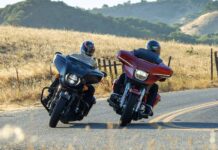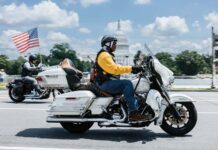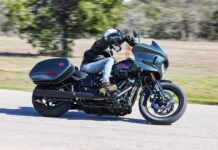New York, N.Y., June 23—It had to be one of the best-kept secrets in Harley’s history. Until, that is, a few photos were leaked from the set of Avengers: Age of Ultron showing the Black Widow character riding an electric motorcycle with the Harley-Davidson logo clearly emblazoned across the body. Just a few days later, on June 19, The Motor Company revealed Project LiveWire, the first electric Harley-Davidson motorcycle.
Prototypes of the motorcycle will be sent on a U.S. tour of 30 Harley-Davidson dealerships this year, and in 2015 the tour will continue in the U.S. and expand to Canada and Europe. The goal is for consumers to provide feedback on LiveWire, helping Harley-Davidson determine whether they will actually release it for production, and if so, what changes will need to be made. This is the first time Harley, or to the best of my knowledge any other motorcycle manufacturer, has developed a prototype to this degree and invited riders to provide feedback without any commitment to bringing it to market.

The official tour kickoff took place at Harley-Davidson of New York City in Manhattan, New York, on June 25, but I arrived at the dealership the morning of the 24th for the media launch. There were six new LiveWire motorcycles parked behind barricades out front, with a crew of media folks about to saddle up. Before riding the new bike, we were required to watch a safety video emphasizing the differences between LiveWire and traditional motorcycles, and sign a disclaimer.

We learned that LiveWire accelerates from 0 to 60 in four seconds flat, and produces 74 hp and 53 ft/lbs of torque, with a top speed of 92 mph. Weight is estimated at 460 pounds (the frame is only 14 lb.). Combined city/highway range is around 53 miles when set on “range ride,” and about 26 miles when on “power ride.” Charging time is 3 ½ hours using a Level 2 charger (get ready for a whole new lexicon for the EV market).
While waiting for my turn at the real thing, I spoke with H-D of NYC General Manager and Parts Manager John Maguire. I started out with, “So Harley-Davidson of New York City is the first stop on the East Coast tour…” John exclaimed, “First on the planet, here in New York City! What’s cooler than on Broadway?” He went on to say, “It is a perfect city vehicle. It’s nimble, it’s agile, it has a wonderful suspension. I got to spend a couple hours on one yesterday, and it handles like a dream. And it’s battery operated. How cool is that? How technologically advanced is The Motor Company that they’re debuting an electric bike?” He continued, “Yesterday as we were going out on our run, people were trying to swerve away from the potholes and the raised manhole covers as they were getting used to the unit, and I thought to myself, what the heck, and I started aiming right for them and I was really, really surprised that the suspension absorbed all of it.”
Carmen Roberts, NYC H.O.G. webmaster and media contact, and NYC H.O.G. Director Joe Sessa were in the first group of consumers to ever ride Project LiveWire. Joe said, “It is very exciting for the motorcycle world. For older people who are getting arthritis in their hands there is no clutch, and if I put my radio on there I could hear every note played.” Carmen said, “I feel the bike would make a great New York City ride. It’s nimble, fast and easy to ride. I love that you don’t have to constantly clutch when you are in stop-and-go traffic like the city. Above all it is a fun bike for short trips.”
Although the bike’s seat is estimated at a height of 30″, I was able to flat foot it, in part because the bike has an exceedingly thin profile. There is no clutch, transmission or exhaust pipe. And of course no gas tank. Even with the absent clutch lever and gear shifter peg, it didn’t take us long to get acclimated. Switching the button on and pressing the starter resulted in only a slight hum, barely audible over the street noise. A digital display showed system status numbers; change settings and the display panel doubles as a GPS.

H-D Northeast Marketing Manager John Mattias led our small group on a 20-minute tour of downtown Manhattan. The Jumpstart Experience had prepared me for the near-instant throttle response and subsequent whirring that sounded like a small jet, but I was surprised by the rapid deceleration as soon as I rolled off the throttle. The “regenerative braking” recharges the batteries, adding miles onto the riding range. It was suggested that, when backing off the throttle, we tap the brake to warn vehicles behind us since nothing indicates we are slowing abruptly. This is something Harley should address before LiveWire hits the market.
The bike was extremely well balanced; I rarely had to put my feet down even when nearly stopped, and was easily able to zip in and out of traffic. The inverted Showa front forks, consisting of fork springs and huge pistons much like a sportbike, coupled with the rear monoshock handled rough road surfaces with grace.

After my fun, but way-too-short, test ride, I spoke with some of the Harley executives on hand for the launch. Jeff Richlen, chief engineer on LiveWire, explained, “What we’re hoping to accomplish is two-fold. First and foremost, we wanted to deliver something that was a great riding experience. When you look at LiveWire, it’s about being a great motorcycle first and the fact that it’s powered by electricity or batteries is secondary. Second thing is to really solicit feedback from our customer. If you look at the way our products are evolving, it really is about being truly customer led and customer focused. We understand that there is a level of maturity that has to come to the EV space, and when we look to what the possibilities are in the future, we want to deliver something that is a credible, capable no-excuses riding experience whether it be an ICE (internal combustion engine) V-Twin or an electric bike that’s powered by batteries. This bike really gets to the essence of what’s great about riding. It’s very limited in its complicated features; the interface is extremely simple. We have to be careful not to put too much into it that customers are not really asking for.”
According to H-D Senior Vice President and Chief Marketing Officer Mark Hans Richer, Harley-Davidson is not a big fan of hybrid technology on a motorcycle. “It’s just too much big stuff to stick on a bike and it compromises weight and all kinds of things. We think this is the smarter way to go. If technology can advance and we can help it advance, we think this is the more direct path to the benefits the customers are looking for.” Although it wasn’t stated at the launch, it appears that Harley has partnered with Mission Motorcycles to develop the motor and driveline. The Motor Company is, however, tightlipped about their battery development partner(s).

Richer described the thinking behind the Project LiveWire Experience: “We feel that this was one of the best-kept secrets around, and that was our intent. We wanted to have real motorcycles for people to ride and not have this be a hypothetical discussion, but a real discussion.” Addressing the target demographic, Richlen continued, “Obviously we’re a powerhouse in the industry, but one of the places we haven’t done traditionally as well in is the urban space. For a more urban dweller that may be coming off a scooter or something of lower displacement, it’ll be a very natural transition.” Richer added, “We’re getting everybody and their uncle here today. We’ve got young people, old people, women, men, every culture and creed that you can imagine. We’ve got Japanese reporters here; we’ve got Brazilians and every single one of them seems to be responding to it in a pretty positive way. If they had to put their money down it might be a different thing, but we’re gonna see based on the response we get where the demographics shake out. We suspect that it might be broader than people might guess.”
Addressing charging standards for EV vehicles, Richer said, “Tesla just recently came out with open source on their intellectual property of their charging system. That could be very interesting to us. It’s a faster charging mechanism and it’s a smaller mechanism, so for both of those reasons it could be favorable to our application.” In response to my question about where charging stations might be set up, “One thing we have as an advantage at Harley-Davidson, especially in the United States, is we have a wonderful community of dealers all across the country, most of them right off highways or major thoroughfares, so we have a natural advantage already.” One would have to assume that owners could charge their bikes at home as well.
He wants Thunder Press readers to know that “Project LiveWire is adding on to what it is we are; we’re not changing who we are. We are everything we’ve ever been and more because we keep investing in Project RUSHMORE and the Street 750 and 500 and these are huge investments; much bigger investments for us than this is. We absolutely love internal combustion and we’re not walking away from internal combustion. We’re gonna continue to make major investments in that experience because it’s an experience that we love and our customers love.”

That evening, H-D of NYC hosted an invite-only V.I.P. party at the dealership, during which H-D President and Chief Operating Officer Matt Levatich took the stage and spoke about the Project LiveWire Experience. He introduced Chief Engineer Jeff Richlen, engineer Ben Lund and Styling Manager Kirk Rasmussen, all part of the design team for LiveWire. Mark Hans Richer took the stage, commenting that “Harley-Davidson has 111 years of fantastic challenges, results and innovations, and ups and downs. This is more like an electric guitar than an electric car. We’re reinventing this company and we’re reinventing the future of Harley-Davidson.”
LiveWire looks much more finished than the usual prototype, and Harley is actively recruiting EV engineers on its website, making it difficult for the media present to believe that the company does not have the bike slated for release within the next few years.
It appears that other electric motorcycle manufacturers are applauding Harley’s foray into the EV arena. Zero Motorcycles, which expects to sell 2,400 units this year (less than 1 percent of Harley’s overall motorcycle sales in 2013), hails this move as validation of EV market viability. The buzz being generated has been considerable, not only in the motorcycle industry, but also in the business, energy, environmental and automotive sectors. If Congress renews the 10-percent federal tax credit for electric motorcycles, that could help propel the movement even further.
Levatich later told me, “Project LiveWire says something very strong about what Harley-Davidson can do as a company and what we can be as a brand. It also represents a nod to a future of electric vehicles, the interests among young adults in particular… and what it means to the environment. We’re not doing any less investment in our core traditional product for our very loyal and passionate existing customers. So it’s not taking away from what everybody knows and loves about Harley; it’s adding to what everyone loves about Harley.”
As Richlen observed, “LiveWire really has to be grounded in our three tenets of Harley-Davidson: looks, sound and feel, and we had to get that right. With this bike, I think we hit it out of the park.” If the riding range is extended to somewhere north of 100 miles and battery recharging time can be reduced to, say, 10 or 15 minutes, I think he may be right.



















Until this bike’s range is well over a 100 “Range Ride,” 50+ “Power Ride” miles and with a recharge time of 10-15 while eating during day trips, the LiveWire just won’t cut it. It is clearly being marketed to the sport bike community given the hideous ergonomics of the riding position — thus the 53 miles commuter “Range Ride mile limitation. And for an urban/commuter bike, where on this design is there any place to carry anything other than on the rider’s back? Keep evolving it, H-D….